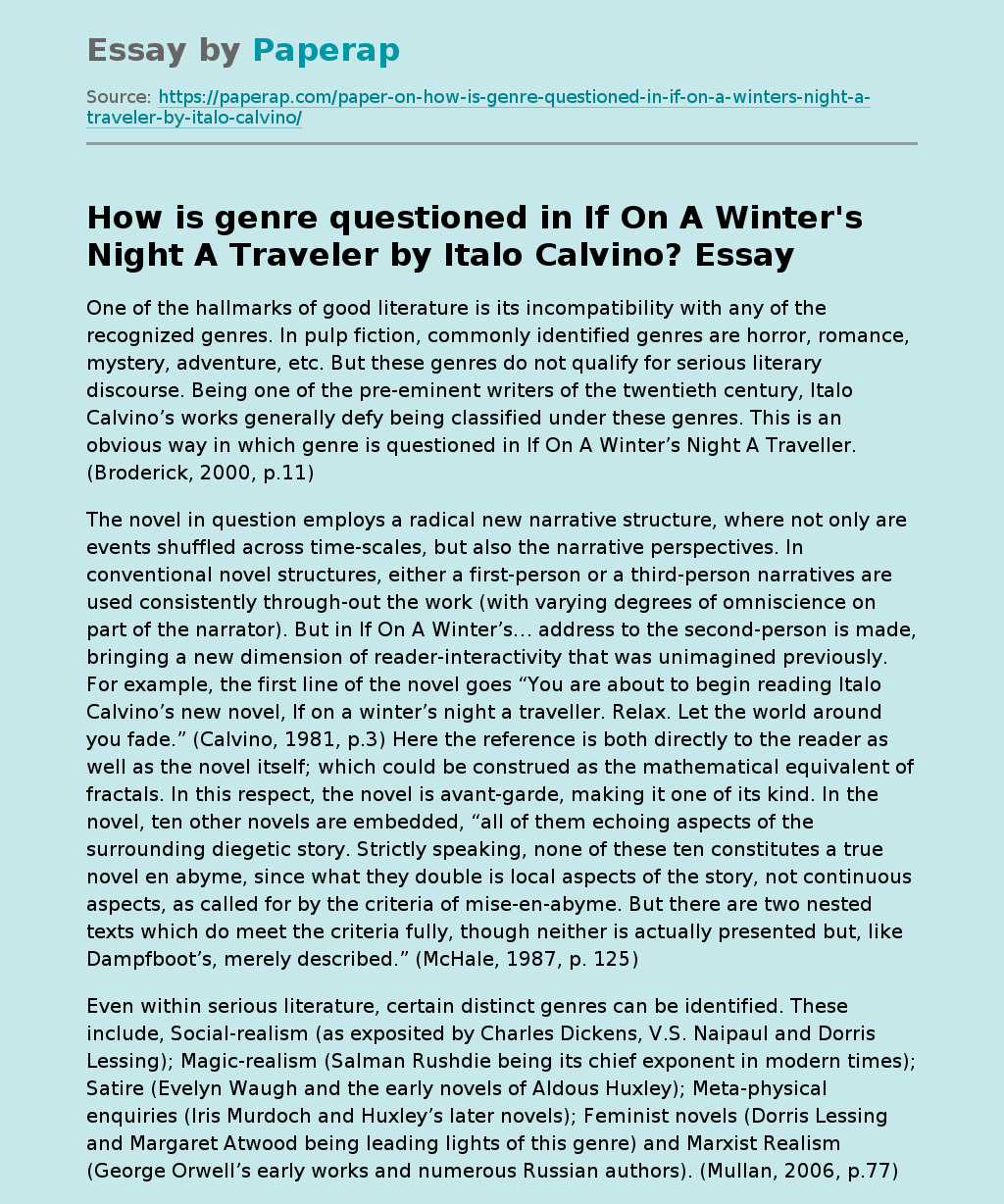How is genre questioned in If On A Winter's Night A Traveler by Italo Calvino?
One of the hallmarks of good literature is its incompatibility with any of the recognized genres. In pulp fiction, commonly identified genres are horror, romance, mystery, adventure, etc. But these genres do not qualify for serious literary discourse. Being one of the pre-eminent writers of the twentieth century, Italo Calvino’s works generally defy being classified under these genres. This is an obvious way in which genre is questioned in If On A Winter’s Night A Traveller. The novel in question employs a radical new narrative structure, where not only are events shuffled across time-scales, but also the narrative perspectives.
In conventional novel structures, either a first-person or a third-person narratives are used consistently through-out the work (with varying degrees of omniscience on part of the narrator). But in If On A Winter’s… address to the second-person is made, bringing a new dimension of reader-interactivity that was unimagined previously. For example, the first line of the novel goes “You are about to begin reading Italo Calvino’s new novel, If on a winter’s night a traveller.
Relax. Let the world around you fade.” Here the reference is both directly to the reader as well as the novel itself; which could be construed as the mathematical equivalent of fractals. In this respect, the novel is avant-garde, making it one of its kind. In the novel, ten other novels are embedded, “all of them echoing aspects of the surrounding diegetic story. Strictly speaking, none of these ten constitutes a true novel en abyme, since what they double is local aspects of the story, not continuous aspects, as called for by the criteria of mise-en-abyme.
But there are two nested texts which do meet the criteria fully, though neither is actually presented but, like Dampfboot’s, merely described.” Even within serious literature, certain distinct genres can be identified. These include, Social-realism (as exposited by Charles Dickens, V.S. Naipaul and Dorris Lessing); Magic-realism (Salman Rushdie being its chief exponent in modern times); Satire (Evelyn Waugh and the early novels of Aldous Huxley); Meta-physical enquiries (Iris Murdoch and Huxley’s later novels); Feminist novels (Dorris Lessing and Margaret Atwood being leading lights of this genre) and Marxist Realism (George Orwell’s early works and numerous Russian authors).
Given Calvino’s experiences in childhood, as well as his father’s involvement with Communist causes, it would be a natural inclination for him to adopt the Social Realism or Marxist Realism genres. Indeed, Calvino has successfully explored and mastered these genres in other works. But what makes If On A Winter’s… unique and places it outside these well-trodden genres are the following aspects. First, the novel carries a labyrinthine and looping narrative structure, whereby the reader is continuously taken from one embedded novel lead to another, without ever resolving any of the started leads.
Second, the employment of second person reference, adds a whole new dynamic to the reading experience, making it more personal, interactive and involving. The work lucidly shows how a text can signify subjective experiences of the reader by immersing him/her in a “process of identification” . For example, the text addresses the reader directly as one of the characters in the plot. As a result, “it foregrounds, as conventional narrations do not, the extent to which your subjectivity as a reader depends upon identification with the signifier you. An effaced narrating agency makes itself apparent only indirectly in the form of imperatives and questions.” Third, the novel is a detailed introspection on the process of writing itself, taking the reader through the complexities and challenges that the author himself faces.
Put together, these aspects of the novel make it unique among 20th century works and place it outside recognized genres. Further, “Metalepsis, the violation of ontological boundaries, is a model or mirror of love. Implicit in the postmodernist use of the second person, this analogy is actually made explicit in certain texts. Calvino ends If on a winter’s night a traveller by having his two Readers, male and female, go to bed together; there, no longer second person singulars but a joint second person plural, they “read” each other in an erotic analogy with the way they have been read as characters.” It is for these aforementioned reasons that If On A Winter’s Night A Traveller can be said to question genres. If anything, this novel has spawned a new genre of its own, albeit whose reach and appeal is confined to esoteric literary circles.
References
- Broderick, D. (2000). Transrealist Fiction: Writing in the Slipstream of Science. Westport, CT: Greenwood Press.
- Calvino, Italo, (1981) If On A Winter’s Night A Traveller, Published by Everyman’s Library.
- Cohan, S., & Shires, L. M. (1988). Telling Stories: A Theoretical Analysis of Narrative Fiction. London: Routledge.
- Fludernik, M. (1994). Second-person Narrative: a Bibliography. Style, 28(4), 525+.
- Francese, J. (2001). Italo Calvino: A Journey toward Postmodernism. 117.
- McHale, B. (1987). Postmodernist Fiction. London: Routledge.
- Mullan, J. (2006). How Novels Work. New York: Oxford University Press.
- Tandello, E. (2007). Semiotics of Re-reading: Guido Gozzano, Aldo Palazzeschi, Italo Calvino. The Modern Language Review, 102(2), 536+.
- Tinkler, A. (2002). Italo Calvino. The Review of Contemporary Fiction, 22(1), 59+.
- Wood, M. (1998). Children of Silence: On Contemporary Fiction. New York: Columbia University Press.
How is genre questioned in If On A Winter's Night A Traveler by Italo Calvino?. (2019, Feb 19). Retrieved from https://paperap.com/paper-on-how-is-genre-questioned-in-if-on-a-winters-night-a-traveler-by-italo-calvino/

